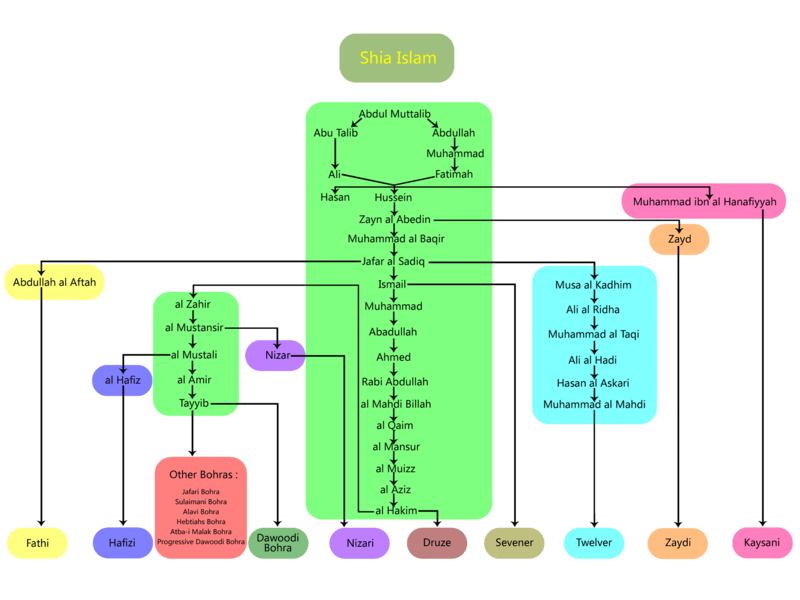Tayyibi Isma'ilism
Ṭayyibi Ismā‘īlism is the only surviving sect of the Musta'li branch of Isma'ilism, the other being Hafizi Isma'ilism. Most followers of Tayyibi Isma'ilism are found in various Bohra communities: Dawoodi, Sulaymani, and Alavi.
The Tayyibi originally split from the Fatimid Caliphate-supporting Hafizi branch by supporting the right of at-Tayyib Abu'l-Qasim to the Imamate.
History
Upon the death of the twentieth Imam, al-Amir bi-Ahkami'l-Lah (d. AH 526 (1131/1132)), his two-year-old child at-Tayyib Abu'l-Qasim (b. AH 524 (1129/1130)) was appointed the twenty-first Imam. As he was not in a position to run the Dawah, Queen Arwa al-Sulayhi, the Da'i al-Mutlaq, acted as his regent. The Da'i had now been given absolute authority and made independent from political activity.
Da'i Zoeb bin Moosa
Da'i Zoeb bin Moosa used to live in and died in Hoos, Yemen. His ma'zoon ("associate") was Khattab bin Hasan. After death of Abdullah, Zoeb bin Moosa appointed Yaqub as the wali ("representative" or "caretaker") of the Tayyibi organization ("dawah") in India. Yaqub was the first person of Indian origin to receive this honor. He was son of Bharmal, minister of the Chaulukya king Jayasimha Siddharaja. Fakhruddin, son of Tarmal, was sent to western Rajasthan. One Da'i after another were continued until the twenty-fourth Da'i, Yusuf Najmuddin ibn Sulaiman, in Yemen. Due to prosecution by a local ruler, the dawah then shifted to India under the twenty-fifth Da'i, Jalal bin Hasan.
The insignificant Tayyibi communities in Egypt and Syria, known as Amiriyya, are only rarely mentioned in the sources. Toward the end of the 6th/12th century there is a vague referenceqto the presence of Amiriyya in Egypt. In Syria a community of Amiriyya is still mentioned about the year 723/1324 in the Baqi'a and Zabud mountains near Safad. These isolated communities probably did not survive much longer. Only in the Yemen and India could the Tayyibi da'wa, under the undisputed leadership of the da'imutlaq, establish itself permanently. After Ibrahim al-Hamidi the position of da'i mutlaq remained among his descendants until 605/1209, when it passed to 'Ali b. Muhammad of the Banu 'l-Walid al-Anf family, which was named after his ancestor Ibrahim al-Anf, who was a prominent supporter of the Salayhids and a descendant of the Umayyad al-Walid b. 'Utba b. Abi Sufyan. It remained in this family, with only two interruptions in the 7th/13th century, until 946/1539.
The traditional stronghold of the Isma'ili da'wa in the Yemen was in the Haraz mountains, though there were scattered communities in other parts of the country. The da'is generally enjoyed the support, or at least protection, of the Hamdanids, who permitted them to reside in San'a' and later, in the 8th/14th century, in the fortress of Dhu Marmar. Their relations with the Ayyubids and the Rasulids were fair, but the Zaydi imams were mostly hostile. The Zaydi pretender al-Mansur 'Ali b. Salah al-Din expelled them from Dhu Marmar in 829/1426 after a prolonged siege, and they established their residence in the Haraz mountains. The Zaydi Imam al-Mutahhar b. Sharaf al-Din in the 10th/16th century relentlessly persecuted the Banu 'l-Anf and seems to have practically extirpated the family. The relations with the da'wa in India remained close. There the Tayyibi community grew mostly undisturbed, though in the first half of the 9th/15th century persecution under the Sultanate of Gujarat resulted in mass conversions to Sunnism. In 946/1539 the position of da'i al mutlaq passed to an Indian, and after his death in 947/1567 the headquarters were transferred to Gujarat in India.
Sulaymani-Dawoodi-Alavi split
In 1592, the Tayyibi broke into two factions in a dispute over who should become the twenty-seventh Da'i: Dawood Bin Qutubshah or Sulayman bin Hassan. The followers of the former, primarily in India, became the Dawoodi Bohra, the latter the Sulaymani of Yemen. In 1637, the Alavi Bohra split from the Dawoodi bohra community.
There is also a community of Sunni Bohra in India. In the fifteenth century, there was schism in the Bohra community of Patan in Gujarat as a large number converted from Mustaali Ismaili Shia Islam to mainstream Hanafi Sunni Islam. The leader of this conversion movement to Sunni was Syed Jafar Ahmad Shirazi who also had the support of Mughal governor of Gujarat. Thus this new group is known as Jafari Bohras, Patani Bohras or Sunni Bohra. In 1538, Syed Jafar Ahmad Shirazi convinced the Patani Bohras to cease social relations with Ismaili Bohras. The cumulative results of these pressures resulted in large number of Bohras converting from Ismaili Shia fiqh to Sunni Hanafi fiqh.
The Hebtiahs Bohra are a branch of Mustaali Ismaili Shi'a Islam that broke off from the mainstream Dawoodi Bohra after the death of the 39th Da'i al-Mutlaq in 1754. The Atba-i-Malak community are a branch of Mustaali Ismaili Shi'a Islam that broke off from the mainstream Dawoodi Bohra after the death of the 46th Da'i al-Mutlaq, under the leadership of Abdul Hussain Jivaji in 1840. They have further split into two more branches, the Atba-e-Malak Badar and Atba-i-Malak Vakil. The Progressive Dawoodi Bohra is a reformist sect within Mustaali Ismai'li Shi'a Islam that broke off circa 1977. They disagree with mainstream Dawoodi Bohra, as led by the Da'i al-Mutlaq, on doctrinal, economic and social issues.
At present, the largest Tayyibi faction/sub-sect is the Dawoodi Bohra, whose current leader is Syedna Mufaddal Saifuddin. Taher Fakhruddin is also a claimant to the title of Dai al Mutlaq since 2016, although it is widely accepted that Syedna Mufaddal Saifuddin is the leader of the Dawoodi Bohras, in all aspects and administration.

References
- The Ismaili, their history and doctrine by Farhad Daftary
- Religion, learning and science by Lathan Young
- Medieval Islamic civilisation by Joseph W. Meri, Bacharach
- Sayyida Hurra: The Isma‘ili Sulayhid Queen of Yemenby Farhad Daftary
- The Uyun al-akhbar is the most complete text written by an Ismaili/Tayyibi/Dawoodi 19th Dai Sayyedna Idris bin Hasan on the history of the Ismaili community from its origins up to the 12th century CE. period of the Fatimid caliphs al-Mustansir (d. 487 AH / 1094 AD), the time of Musta‘lian rulers including al-Musta‘li (d. 495 AH / 1102 AD) and al-Amir (d. 526 AH / 1132 AD), and then the Tayyibi Ismaili community in Yemen.
